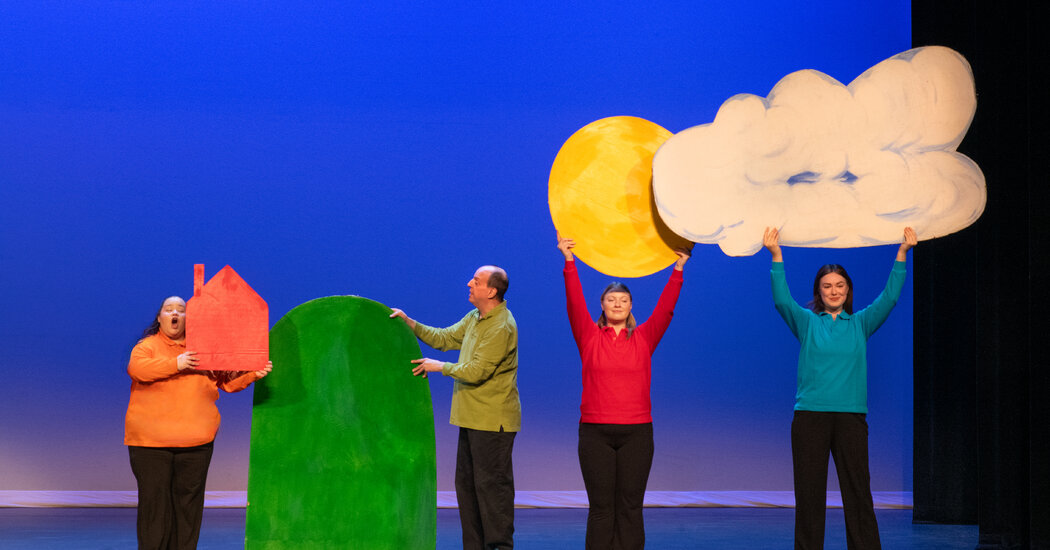What fun can you have with plain brown grocery sacks and empty cardboard cartons?
Preschoolers know how to derive joy from these objects (as does any curious cat). But perhaps the best way to appreciate their magical potential is to watch the Paper Bag Players, a New York City children’s theater company that thrives on turning the ordinary into the unexpected.
Families can experience that transformative power on Sunday, when the nonprofit troupe presents “It’s a Marvelous Paper Bag World!” at the Kaye Playhouse in Manhattan. (They will also perform in April at the Jewish Museum and SUNY Orange in Middletown, N.Y.) The production consists of 13 musical skits tailored for audiences ages 3 to 9, and it celebrates a milestone that any performing-arts organization would envy: the company’s 65th season, making it one of the longest-operating children’s theater troupes in the nation.
“At the heart of our theater is making imaginative use of materials,” John Stone, the players’ executive director, composer and music director, said during a group interview with the company’s principals.
The troupe’s devotion to paper and cardboard, from which it has devised sets, props and towering characters, dates to its earliest days. In 1958, its founders, who included the dancers Judith Martin and Remy Charlip, began to experiment with simple objects. Over the years, the raw materials have expanded to include foam board, Tyvek and household tools like mop heads.
“We take our inspiration from them,” Stone said of children. “Then we’re making our own sorts of things with them in mind, or with their kind of play in mind. And that gives it back to the kids. And it’s an upward spiral of inspiration.”
The Obie Award-winning company’s distinctiveness, however, extends beyond its onstage components. (Jonathan Peck designed the sets for years; Florencia Escudero is the current scenic artist.) From the beginning, the players have avoided adapting fairy tales or popular classics.
“Everything is original,” said Kevin Richard Woodall, the troupe’s stage director, choreographer and longtime cast member. Among children’s companies, he added, “we’re really one of the only ones that do that.”
For decades, Martin, the company’s original artistic director, created many of the skits with the composer Donald Ashwander; since 2009, Woodall and Stone have been writing material. The sketches often introduce fantastical elements to real-life settings: a subway car, a park bench, a kitchen with a leak (the water runs away from the plumber), or even a Paper Bag performance-within-the-performance. If someone were to create a “Saturday Night Live” for children, it would resemble these shows.
Most seasons combine fresh skits with some of the players’ classics. The current production includes “Lost in the Mall,” a 1991 piece starring what Stone calls “tube people” — Woodall and his fellow actors Ceili Fitzpatrick, Claire Lundin and Erika Mesa, all wrapped in cardboard — who keep losing track of one another.
In the audience, “the kids just get driven crazy,” Stone said, as they see that in the onstage family, “this kid is not finding their parent, and the parent’s not finding their kid, over and over.” Before long, little theatergoers “are ready to jump out of their seats and help,” he said.
Jumping out of seats is a given at a Paper Bag show, for which Stone often writes singalong, dance-along ditties. Drawing on influences as disparate as ragtime, klezmer and Gilbert and Sullivan, he plays all the music himself, seated onstage at an electric keyboard.
He also provides sound effects, which can be playfully boorish for a character like the eight-foot-tall Bob the Slob, a fan favorite who constantly and noisily eats. In the new skit “I Won,” Bob uses bingo prize money for a ticket to the players’ show. When he is asked to fill in on a song number, hilarity ensues.
Not all the skits are boisterous. Every show incorporates gentle, lyrical pieces that land with the pure stillness of snow. This year, the players have revived one of their oldest: “Big Red Day” (1960), in which they take the sun, clouds, a mountain and a house through changes that include shifting weather. Night arrives when a player flips over a cardboard cloud to reveal a starry sky.
Ariane Anthony, the company’s managing director, recalled that Martin, who compared such works to poetry, noted that “children don’t have enough poetry in their lives,” Anthony said. “And they like poetry.”
Adolescents admire it, too. In a phone interview, Hannah Heijink, 16, a high school sophomore in Accord, N.Y., called the players’ work “a stress reliever, and not just for little kids.”
“As a teenager, I still love them,” said Heijink, whose parents know Stone and who grew up watching the shows.
The troupe’s principals attribute the company’s longevity to its commitment to not talk down to its audience. “We want to entertain ourselves,” Stone said. And while the players have struggled financially in recent years — the coronavirus pandemic, which stopped all live performances, was a major hardship — they hope to return to an expanded schedule of public shows and touring. A majority of their current performances are for schools, which receive an accompanying study guide.
But although children can learn from a Paper Bag production, its themes are less academic than social.
“In almost every show, we have a piece that’s about becoming friends, or getting to know someone that is very different from yourself,” Anthony said. “It’s a Marvelous Paper Bag World” includes “Volcano” (2011), which wryly subverts traditional tropes by featuring a dragon that is far from ferocious.
When children attend a show, “I don’t care if they walk out and learn anything,” Woodall said, “because I just want them to, for 55 minutes, forget school, forget everything. Just come to Paper Bag World with us.”
